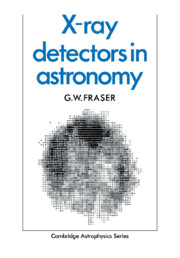Book contents
- Frontmatter
- Contents
- Preface
- Acknowledgements
- Units and constants
- 1 Observational techniques in X-ray astronomy
- 2 Proportional counters
- 3 Microchannel plates
- 4 Semiconductor detectors
- 5 Scintillators, phosphors and NEADs
- 6 Single photon calorimeters
- Appendix A Observational X-ray astronomy: a bibliography
- Appendix B X-ray data analysis techniques
- References
- Index
5 - Scintillators, phosphors and NEADs
Published online by Cambridge University Press: 21 May 2010
- Frontmatter
- Contents
- Preface
- Acknowledgements
- Units and constants
- 1 Observational techniques in X-ray astronomy
- 2 Proportional counters
- 3 Microchannel plates
- 4 Semiconductor detectors
- 5 Scintillators, phosphors and NEADs
- 6 Single photon calorimeters
- Appendix A Observational X-ray astronomy: a bibliography
- Appendix B X-ray data analysis techniques
- References
- Index
Summary
Introduction
This chapter describes the uses-past, present and proposed-of three types of solid X-ray converter in soft X-ray astronomy: scintillators and phosphors, which work by the conversion of X-ray energy into visible light and negative electron affinity detectors (NEADs), which rely on external photoemission from a surface activated to a state of negative electron affinity. Although the terms scintillator and phosphor are formally synonyms (Thewlis, 1962), we shall adopt the usage prevalent in the detector literature and distinguish between bulk, crystalline materials such as Nal(Tl) and CsI(Na) (scintillators) and thin, granular layers of, for example, the rare earth oxysulphides (phosphors). Phosphors are often identified by a commercial T-number’. A partial list of such numbers is given by Gruner et al (1982).
The use of luminescent solids in nuclear physics has a long tradition. Rutherford's nuclear model of the atom (1909), for example, had as its experimental basis the observation, by eye, of α-particle induced light flashes (scintillations) on a zinc sulphide screen. The substitution of a photomultiplier tube for the human observer, which first occurred towards the end of the second world war, produced a sensitive electronic counter for γ-rays and particles, whose operation is described in texts such as those of Curran (1953), Birks (1964) and Knoll (1979).
The first use of a scintillation counter in X-ray astronomy was in a balloon-borne observation of the Crab Nebula in 1964 (Clark, 1965). As described in section 1.2, such balloon payloads were limited, because of atmospheric opacity, to the spectral band E > 20 ke V, where source fluxes decrease rapidly with increasing X-ray energy.
- Type
- Chapter
- Information
- X-ray Detectors in Astronomy , pp. 230 - 253Publisher: Cambridge University PressPrint publication year: 1989

